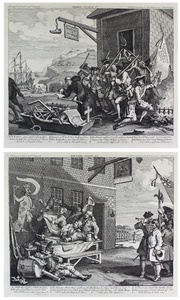| Method | Copper engraving |
| Artist | William Hogarth |
| Published | Design'd & Etch'd by Wm. Hogarth, Publish' d according to Act of Parliament March 8th, 1756. [John & Josiah Boydell, London 1790] |
| Dimensions | Images 290 x 376 mm, Plates 321 x 390 mm, Sheets 435 x 588 mm |
| Notes |
A pair of propaganda prints initially executed at the outbreak of the Seven Years War in 1756. In response to a feared invasion of England by France, Hogarth completed two views to show the comparative state of affairs in the two countries. Each was accompanied by twelve lines of verse penned by Hogarth's friend and the greatest actor of the age, David Garrick. The prints differed from others of the time by their show of morale and optimism in a social climate that was decidedly panicked and defeatist. France, Plate 1st: A seaside town shows the preparations for an imminent invasion of Britain. In the background, ranks of French soldiers are unwillingly boarding a warship, goaded up the gangplank by their officers with large sticks. In the foreground is a tavern, advertising 'Soup Meagre a la Sabot Royal' on a sign, from which an old shoe hangs on a hook. Outside the tavern, a motley group of starving and dejected French soldiers are being exhorted by their captain, who roasts a string of frogs on his sword over a bonfire and gestures to a flag that reads 'Vengence et le Bon Bier et Bon Beuf de Angleterre.' In front of this group, an evil-looking monk tests the edge of his axe with his forefinger, a sledge full of his belongings being dragged by a horse. These include implements of torture, suggestive of the Inquisition, a statue of Saint Antony, and a Plan of London Blackfriars. Below the image, a twelve line poem reads: 'With lanthern jaws, and croaking Gut, / See how the half-starv'd Frenchmen Strut, / And call us English Dogs! / But soon we'll teach these bragging Foes, That Beef & Beer give heavier Blows, than Soup & Roasted Frogs. / The Priests inflam'd with righteous hopes, / Prepare their Axes, Wheels & Ropes, / To bend the Stiff neckt Sinner; / But should they sink in coming over, / Old Nick may fish 'twixt France & Dover / And catch a glorious Dinner!' Paulson 202 iii/iii, BM Satires 3446 England, Plate 2nd: In England, the hale and hearty soldiery are merry and prepared. The scene is set outside the 'Duke of Cumberland' Inn, named for the victor of Culloden and alluding to the French defeat at their last attempt to invade. In the distance, a regiment of soldiers stand to attention before their officer. Those off duty enjoy themselves outside the Inn. A soldier, smoking a long pipe, paints a grotesque caricature of the King of France on the Wall. The King, armed with a sword and holding a gallows, is given a speech bubble which in broken English labels the English as 'pirates.' Two serving girls admire the soldier, measuring his wide shoulders, while two of his fellows whoop encouragingly. On the table is a massive side of beef, and a note with the words to 'Rule Britannia' written on it. Sitting on the ground beside the table, the regimental musician practices 'God Save Great George Our King' on his pipe, while a recruiter measures the height of a burly young lad. Below the image, a twelve line poem reads: 'See John the Soldier, Jack the Tar, / With Sword & Pistol arm'd for War, / Should Mounsir dare come here! / The Hungry Slaves have smelt our Food, / They long to taste our Flesh and Blood. / Old England Beef and Beer! / Britons to Arms! and let 'em come, / Be you but Britons still, Strike Home, / And Lion-like attack 'em; / No Power can stand the deadly Stroke, / That's given from hands & hearts of Oak, / With Liberty to back em!' Paulson 203 iii/iii, BM Satires 3454 William Hogarth (1697 - 1764) was born in London, the son of an unsuccessful schoolmaster and writer from Westmoreland. After apprenticeship to a goldsmith, he began to produce his own engraved designs in about 1710. He later took up oil painting, starting with small portrait groups called conversation pieces. He went on to create a series of paintings satirising contemporary customs, but based on earlier Italian prints, of which the first was The Harlot's Progress (1731), and perhaps the most famous The Rake's Progress. His engravings were so plagiarised that he lobbied for the Copyright Act of 1735, commonly referred to as 'Hogarth's Act,' as a protection for writers and artists. During the 1730s Hogarth also developed into an original painter of life-sized portraits, and created the first of several history paintings in the grand manner. Condition: Excellent impressions with full margins. |
| Framing | unmounted |
| Price | £475.00 |
| Stock ID | 46312 |

